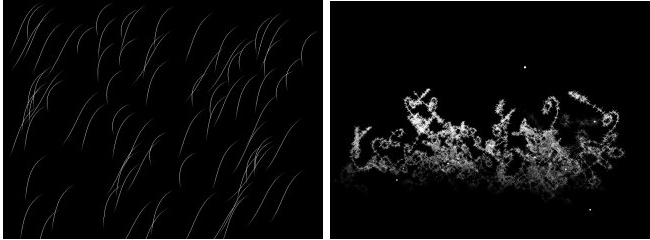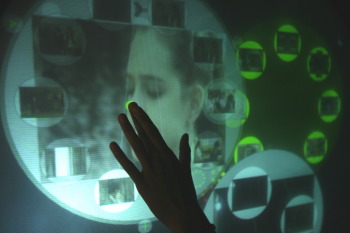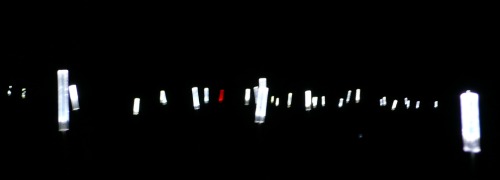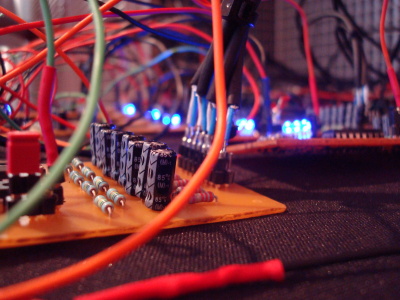AVLAB 1.0 - Project Showcase

Also, Experimentaclub08 Music Festival has exhibited two of them, Bri 2.0 and W_Space... within the context of the Sound Project Showcase, that took place from October 2 through 5 at the D Space of La Casa Encendida in Madrid.
Projects on Showcase:
· Sprocket, by Bruno Vianna and Maíra Sala (Brasil)
· Bri 2.0 (*), by Marcel Bilurbina Camps and Raúl Díaz Poblete, with Pau Sugranyes Coca (España)
· Waves to Waves to Waves, by Damian Stewart and Chris Sugrue (New Zealand / EEUU)
· Estación Pirata, by Rosa Apablaza Valenzuela (Chile)
· Pulverización 3.0 - Bacteria electrónica programable, by Diego Javier Alberti (Argentina)
· Vídeo para invidentes, by Fernando Baena and Beatriz Caravaggio (España)
· Sangoma, de James Webb (Sudáfrica)
· W_space... (*), by Tom Tlalim and Paola Tognazzi (Holanda/Israel/Italia)
· Avis Data, by Kepa Landa Maritorena (España)
[download AVLAB 1.0 dossier in Spanish (pdf)]
Sprocket
by Bruno Vianna y Maíra Sala (Brazil). Collaborators: Alexandre Rangel, Gorka Aguado, Israel Segoviano, Josecarlos Flórez and Roberto Moreno.

A physical interface for editing live cinema. Designed for editing and manipulating narrative films in movie theatres, although it has additional applications. The idea for the tool arose out of the need to develop a specific environment for editing live cinema, different from software currently available to VJs, which does not cover all the needs of narrative films.
The system enables live ordering of takes and scenes, with a multi-touch interface, permitting a creative approach to the editing process of narrative or experimental cinema.
The entire project has been developed in open source, as an open hardware tool. It will be based on the technology created for “Reactable Project” (http://reactable.iua.upf.edu/), , thanks to the collaboration of its developers, in addition to the Universitat Pompeu Fabra and the Hangar Cultural Centre in Barcelona. The code will be published under an open source licence and its development will continue after the workshop ends. The footage will be published on-line using p2p networks, under Creative Commons licence, like Vianna’s film, Cafuné. (http://icommons.org/articles/cafune-breaking-the-limits-for-open-business-models).
http://geral.etc.br/engranaje/
Watch Vídeo in youtube
Bri 2.0 (*)
by Marcel Bilurbina Camps and Raúl Díaz Poblete (Spain) with Pau Sugranyes Coca. Collaborators: Roberto Canduela Luengo, Guillermo Casado, Carla Capeto, Sammy Delgado, Jose Carlos Florez, Oscar Martín, Roberto Moreno, Daniel Pietrosemoli, Elina Roditou and Paola Rodríguez Salillas.

An interactive audiovisual system based on a set of “bris” that serve as a physical interface between the user and the environment. A “bri” is a rod with a luminous tip; its name is derived from its similarity to a “brizna de hierba” (a blade of grass). It forms the basic cell of the interactive system.
Therefore, the system of bris is a visual system (or work) in its own right, and also an instrument or interface for the sound modification of space.
The “internal communication” among the rods, directed by the "master bris", is shown through each bri's lights, creating a sequence of lights that offers the user visual information on the internal communication processes of the system. Audio information on those processes is also provided: a low activity level in the system creates a compact, uniform sound mass, while high communication levels generate sound variations that break up the unity of the sound mass, generating a granular, discontinuous texture.
Waves to Waves to Waves
by Damian Stewart and Chris Sugrue (New Zealand / USA). Collaborators: Servando Barreiro, Carla Capeto, Mariana Caranza, María José Alós Esperón, Sergio Manuel Galán Nieto.

A performance driven by transformations of electromagnetic data into sound and image. Real-time transmissions of varying frequencies become source for sound textures that are in turn used to alter, manipulate and animate video footage of the antennae and sensing devices that grow from our cities' rooftops.
The user moves through space with various electromagnetic tracing devices. Each device reads the fields of waves differently: some gather local signals broadcast from computers and electronic equipment, while others collect waves that are moving through space.
In this performance, this electromagnetic mass becomes directly and indirectly perceptible, awakening a new awareness of the electromagnetic environment through sound: with the manipulation of the video derived from the sound results, we will achieve a transformation in our level of awareness of the visual conglomerate that always accompanies the invisible field of discs, antennae, and communication technology, which are both its cause and its result.
http://csugrue.com/
http://www.frey.co.nz/
Pirate Station (Estación Pirata)
by Rosa Apablaza Valenzuela (Chile). Collaborators: Rolando Carileo Nova, Charis Chlorou, Servando Barreiro, Alberto Cerro, Antía Vilela, Fernando Godoy, Jaime Lobato, Editorial Anagal, Radio Almenara, Martín Estévez, Jay from Sin Antena and everyone we interviewed.

Estación pirata (Pirate Station) comprises the development of research on pirate radios-- temporary, ephemeral, nomadic, illegal and clandestine— heard or functioning in the city of Madrid or its surrounding areas. Pirate radios are radio stations that broadcast without legal permits, given that in order to use radio stations, an authorization acquired by passing an official examination in Telecommunications is required. In addition, the radio station to be used must be legalized.
To carry out this project, a radio station was built based on an electronic circuit at www.piradio.de, which is connected to a computer with audio files reproduced through the radio via the interception of the circuit on the electromagnetic spectrum and "squatting" on the dial.
On the computer, one chooses the audio files one wants to listen to and they are broadcast in real time over the radio, through "squatting" on the dial. More information is available on the blog which is open in the computer.
http://www.estacionpirata.blogspot.com/
Pulverización 3.0 -Bacteria electrónica programable
by Diego Javier Alberti (Argentina). Collaborators: Rafael de Staël, Alberto Cerro

The result is electronic “bacteria” able to process and recycle electronic elements to achieve other new ones. The bacteria consist of eight FM radios and 40 speakers connected to a central system. The radios are the entrance point to the system, taking up radiophonic signals from various local stations at a given moment, and submitting them to granular processing. Granular synthesis is a process through which new sounds are obtained based on very small fragments of other sounds reproduced as a continuous sequence. Eight radios capture different signals from local radio stations. A multiplexor combines the sound signals in a granular way, that is, by taking small audio segments and organizing them into a continuous chain. The audio generated is taken to a set of de-multiplexors that distribute the signal to each of the speakers in an individual way.
This installation is completely analogical. Its design is based on multimedia speakers, FM radios and specially designed electronics with minimal components. It does not use Arduino or any other type of microcontroller. It is 100% discreet electronics.
http://olaconmuchospeces.com.ar/
Video for the blind (Vídeo para invidentes)
by Fernando Baena y Beatriz Caravaggio (Spain). Collaborators: María Botella, Simón Dell and Óscar Martín. With the participation of: Mariu del Amo, José María Nicolás, Carlos Galindo and Rafael Sánchez Mateos.
The incorporation of the blind into audiovisual culture is a right that the blind are demanding increasingly. It is a matter of questioning the power of description and dialogue as a means of representing images and actions and, through them, concepts and feelings. Misunderstandings, implications, the traps of language, the tricks of images… editing. The result is a documentary, experimental video about the relation of blind people to audiovisual products.The project developed is a video installation with two video and audio channels on the subject of the obstacles to be found on a walk anywhere in the city, which are especially problematic for the blind.
Audio-description is used in cinema adapted for the blind to offer them more data than are provided in the original dialogues. The technique consists of including brief, significant descriptions and other interesting facts, making use of the silences between utterances. Its aim is to achieve more inclusion of this group. Vídeo para invidentes (Video for the Blind) has the same objectives but aims to integrate the blind not only as audience members but also due to the subject and their active participation in making the video and enjoying it. Moreover, while commercial audio-description involves a text originally created for the sighted and subsequently adjusted for the blind, in our video, the blind and sighted people’s descriptions are parallel and of equal value. In this way, each offers an audio-description for the other group.
Sangoma
by James Webb (South Africa). Collaborators: Lena Schniewind and Simon Dell.
This installation takes as its starting point the sound recording of a Sangoma–a tradition South African witch-doctor–going into a trance and communicating with his ancestors.
During the two weeks of the workshop, the group experimented with different types of sound, creating a piece adapted to the space at Medialab-Prado. In addition, various types of sensors were found to be used to 'activate’ different sound levels in the piece.
Stand in front of the project and listen. Four speakers and an amplifier are used. The ‘electric eye’ sensor is linked to PureData through FirmData to fire five randomly chosen audio files when a visitor approaches the installation.
http://theotherjameswebb.blogspot.com/
W_space... (*)
by Tom Tlalim y Paola Tognazzi (Holland/Israel/Italy). Collaborators: Alyssa Brackin, Agnese Mosconi, Jaime Alonso Lobato Cardoso, Francesca Mereu, Maria Chiara Paganini, Carlos Panero, Ángela Ramos, Steven Pickels aka Pix, Simon Dell, Roberto Moreno Moya, Daniel Pietrosemoli.

This project develops a musical instrument that shortens the distance between the human body and technological tools. The instrument becomes an extension of the body that allows the body to be a musical instrument and to develop an awareness of its state of being.
One of the objectives is to allow practices that facilitate the emergence of deep, elaborate and "hidden" possibilities of the body, starting with direct, immediate results that encourage the user to play with the instrument/body. The development of this cheap, DIY-type tool for capturing movement is based on the Nintendo Wii remote control system that allows users to use their bodies to communicate, create and share private experiences of spatial movements. The instrument then becomes an extension of the body that allows the body to express itself and become more aware of its states.
You must put on bracelets with sensors in them to use this instrument. When you move, the sensors send data to the programme and it interprets them so that, with each movement, different sounds are produced with which you can compose music.
Avis Data
by Kepa Landa Maritorena (Spain), with Lino Gracía and José Carlos Cortizo. Collaborator: María Jesús De Pablo Carrión

This project aims to represent, through sound, variations in air pollution levels in Madrid. It is based on the concept of bio-indicators, species that alter their behaviour in response to variations in environmental factors.
The Madrid City Council has a network of sensors that analyze levels of chemicals in the air (O3, NO2, CO, SO2, particles, etc.) and publish them on the Internet. Those measurements are captured and compared with this project’s reference figures. Their variations are applied to the measurements of birdsong in tone and length, generating a sound representation of the chemical variations in the air.
If air quality is at an optimal level, no variation will be made on the natural sound. If there is an excess of one type of gas, the same percentage of sound qualities in the song will be altered, such as the tone. Thus, we will begin to perceive the environmental alteration as the experience of other "living beings" acting, metaphorically in this case, as bio-indicators.
HOW IS IT USED?
The intervention takes place discreetly in a city square; at first, it does not attract notice or make us look at it, until we start to detect that some birds are singing very strangely. It invites us to expand our attention beyond visual perception and notice the small details with which nature informs us of its state.
* Project selected for the Sound Projects Exhibit at the EXPerimentaclub'08 Festival, which was exhibited in Space D at the La Casa Encendida de Madrid, from 2 to 5 October 2008.



 Medialab-Matadero Madrid
Medialab-Matadero Madrid